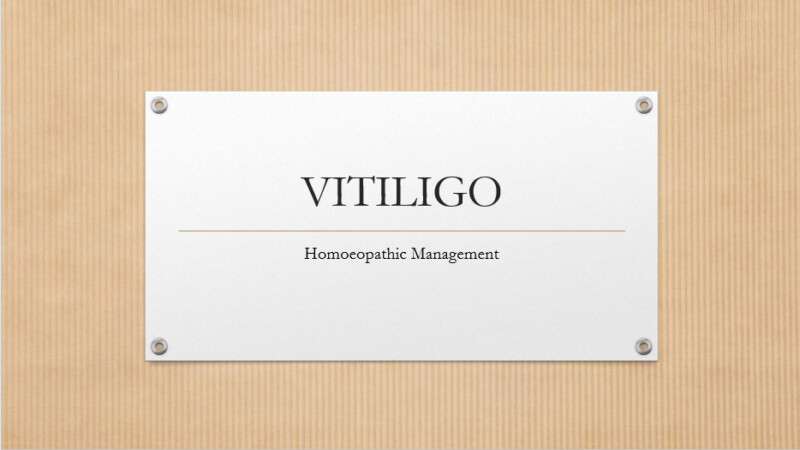INTRODUCTION-
Vitiligo is a skin pigmentation disorder generally characterized by white patches of skin on different parts of the body. Melanocytes or skin-pigment cells present in the skin are usually affected (Melanocytes responsible for skin-pigment are either destroyed by auto-antibodies or they destroy themselves), mucous membrane and the retina may also show signs of loss of this pigment.
It may be related to:-
1)A disorder of the immune system (autoimmune condition)
2)Family history (heredity)
3)A trigger event, such as stress, severe sunburn or skin trauma, such as contact with a chemical.
It is estimated that 1-2% of the world’s population around the globe are affected by Vitiligo. It is indiscriminate of race, sex and age, however most individuals affected are below the age of 45 years. Normally, the color of hair and skin is determined by melanin. As we are aware there is no known cause of Vitiligo and the specific mechanism of its manifestation unknown so it occurs when cells that produce melanin die or stop functioning. Vitiligo affects people of all skin types, but it may be more noticeable in people with darker skin. The condition is not life-threatening or contagious but it can be stressful or make you feel bad about yourself.
In current medical practice, treatment for vitiligo may restore color to the affected skin. But it doesn’t prevent continued loss of skin color or a recurrence.

SIGN AND SYMPTOMS–
Vitiligo signs include:-
1)Patchy loss of skin color, which usually first appears on the hands, face, and areas around body openings and the genitals.
2)Premature whitening or graying of the hair on your scalp, eyelashes, eyebrows or beard.
3)Loss of color in the tissues that line the inside of your mouth and nose (mucous membranes).
Depending on the type of vitiligo you have, it may affect:-
1)Nearly all skin surfaces, with this type, called universal vitiligo, the discoloration affects nearly all skin surfaces.
2)Many parts of your body, with this most common type called generalized vitiligo, the discolored patches often progress similarly on corresponding body parts (symmetrically).
3)Only one side or part of your body, this type is called segmental vitiligo, tends to occur at a younger age, progress for a year or two, then stop.
4)One or only a few areas of your body, this type is called localized (focal) vitiligo.
5)When face and hands are the only part affected, this type is called acrofacial vitiligo, the affected skin is on the face and hands, and around body openings, such as the eyes, nose and ears.
In homoeopathy ,Vitiligo can best be handled and cured if a suitable constitutional remedy can be ascertained and prescribed intermittently. Alongside remedies which are known to have a specific effect on melanin cells and the condition itself as commonly mentioned in our repertories and by other homeopaths need to be used too.
HOMOEOPATHIC MANAGEMENT-
Remedies we find useful and have shown to reverse Vitiligo even if the remedy does not cover all or most of the constitutional features are: 1)Arsenic Album
2) Arsenicum Sulp Flavum
3) Cantharis
3)Sepia
4)Sulphur
5) Hydrocotyle Asiatica tincture and
6) Psoralia Corylifolia tincture.
However, in general practice over 50% of cases may fail to respond or respond very slowly to the remedies above.
If the patient’s constitutional remedy (stressing mainly on the personality traits and generals) can be identified and prescribed the chances of disease progression or a swift recovery can be guaranteed.
Most commonly used constitutional remedies used in such cases are as follows:
1)Arsenic Album: For patients usually lean, dark complexioned, restless, fastidious and anxious. Great remedy for those also having and seasonal allergies.
2)Calcarea Carb: Usually chilly, obese, over worked, over worried patients with a tendency to catch cold. May have hypothyroidism, constipation, menstrual irregularities and PCOD. Usually face numerous fears.
3)Sepia: Usually for depressed, detached, indifferent, weepy and moody individuals with a history of skin and menstrual complaints.
4)Silicea: Suitable for those with defective assimilation, feeble, anxious, timid, bashful, sensitive, lack confidence, obstinate, nervous, chilly, sweaty individuals. A psoric remedy for those with unhealthy skin.
5)Natrum Muriaticum: Usually for reserved, perfectionists, introverts who tend to suppress emotions and dwell on them. They tend to become aloof and do not like to be consoled.
6)Natrum Carb: May help those who are depressed with an aversion to mental labor.
7)Kali Carb: Usually irritable, rigid, stubborn, opinionated, fearful and restless. Very much like a dictator.
8)Carcinocin: Usually for children or even adults who have had strict parents and have been molded early on in life. Those either abused or controlled excessively and are now breaking down. Those who may have taken on too much responsibility or had to submit to a higher authority.
Here,mentioned above are only some of the remedies which are used but surely the most frequently ones used in homoeopathic management of vitiligo.
HAPPY HEALING
Contributor- Dr. Apurva Varangi




